R-16: Difference between revisions
Pbcjohnston (talk | contribs) (Added photos and formatted) |
Pbcjohnston (talk | contribs) (Added captions) |
||
| Line 3: | Line 3: | ||
=== <big>Exterior and Crew Photos</big> === | === <big>Exterior and Crew Photos</big> === | ||
[[File:R-16 construction.jpg|left|500px]] | [[File:R-16 construction.jpg|left|500px]] | ||
<div style="text-align: justify;"><span style="color:#00008B"> | <div style="text-align: justify;"><span style="color:#00008B">R-16 under construction at the Bethlehem San Francisco (BSF) yard, January 3, 1918. Two of her sisters are on either side. BSF launched their boats only about 20% complete, finishing the work while the boat was sitting alongside a fitting out pier. BSF was very busy with wartime shipbuilding contracts, and had to clear the ways so that a new hull could be laid down. Their relatively roomy waterfront allowed them to do this. Other yards, like Bethlehem Quincy in Massachusetts launched the boat when it was about 59% complete. This photo shows her with a false bow that was added for the launch. It would later be replaced with a permanent one with a towing fairlead through the stem. R-16 is sitting very high in the water; both of her upper torpedo tubes are visible. The vertical cylinder in the center is the conning tower. Note the open hatch at the top that will eventually lead to the bridge. The conning tower will have an extensive fairwater built around it that will also form the supporting periscope shears. | ||
<small>Photo | <small>Photo courtesy of the Submarine Force Library & Museum.</small> | ||
[[File:Red bar sub new.jpg]] | [[File:Red bar sub new.jpg]] | ||
[[File:R-16 stern planes.jpg|left|500px]] | [[File:R-16 stern planes.jpg|left|500px]] | ||
<div style="text-align: justify;"><span style="color:#00008B">The rudder and stern planes of the R-16 while the boat was under construction on January 3, 1918 in San Francisco. The axial mounted rudder is attached right at the end of the hull. A push rod exits the aft skeg and is attached to the rudder. This rod enters the hull through a watertight packing gland and is used by the electrical steering gear inside the motor room to move the rudder left or right. Both of the stern planes are angled downward in the full dive position. The twin propellers have not yet been installed just forward of the planes. | |||
<small>Photo courtesy of the Submarine Force Library & Museum.</small> | |||
[[File:Red bar sub new.jpg]] | |||
[[File:R-16 crew photo.jpg|left|500px]] | [[File:R-16 crew photo.jpg|left|500px]] | ||
<div style="text-align: justify;"><span style="color:#00008B">A very nice crew photo of the R-16, likely taken in Pearl Harbor in the early 1920's by famed Hawaiian photographer Tai Sing Loo. The young boy in front is likely the son of the commanding officer. Submarines and ships of the era sometimes had ceremonial mascots of young boys, so this young lad might be that too. The deck gun has been turned to port and the back row of men are standing on it. | |||
<small>U.S. Navy photo.</small> | |||
[[File:Red bar sub new.jpg]] | |||
[[File:R-16 port side with 93.jpg|left|500px]] | [[File:R-16 port side with 93.jpg|left|500px]] | ||
<div style="text-align: justify;"><span style="color:#00008B">This photo of R-16 was taken in Pearl Harbor in the mid 1920's. It illustrates an unusual feature for the time. Instead of the boat's name (R-16) painted on the side of the fairwater, the boat's hull number is there (93). Although a Navy standard after 1938, having the hull number displayed during this time was quite rare. Why it is being done here is not known. All other R-class photos of this era show the name. That makes this view unique. | |||
<small>Photo courtesy of the USSVWII via Navsource.org</small> | |||
[[File:Red bar sub new.jpg]] | [[File:Red bar sub new.jpg]] | ||
<div style="text-align: justify;"><span style="color:#000000"> | |||
=== <big>Interior Photos</big> === | === <big>Interior Photos</big> === | ||
=== Notes === | |||
</div> | |||
<div style="text-align: justify;"><span style="color:#00008B">A large number of interior photos of the R-16 were discovered at the Vallejo Naval & Historical Museum by submarine researcher Darryl Baker. He kindly took the time to scan the images and send them on to PigBoats.COM for posting. We have worked at bringing out as much detail of the images as possible and in a number occasions even make close-ups of interesting bits of information. The photos are reported to have been taken in 1923. | |||
[[File:Red bar sub new.jpg]] | |||
<div style="text-align: justify;"><span style="color:#000000"> | |||
=== Torpedo Room === | === Torpedo Room === | ||
</div> | |||
[[File:R-16 torpedo tube doors.jpg|left|500px]] | [[File:R-16 torpedo tube doors.jpg|left|500px]] | ||
<div style="text-align: justify;"><span style="color:#00008B">The R-16 torpedo tube doors. You can see that the hull narrows quite a lot at this point by the curvature of the hull frames. The hull at this point is not a true circle but a vertical ellipse. | |||
Each door has a sea pressure gauge and sight glass except for door on Number One torpedo tube. The sight glass may have been damaged and has yet to be replaced. The tubes are numbered from right to left and top to bottom; 1, 2 and 3, 4. Odd numbers on the starboard side and even on the port side. The row of large wheel handles are for opening and closing the shutter doors on the outside of the bow. The shutters are inter-linked with the torpedo tube muzzle door that close off the seaward end of the torpedo tube. | |||
The black squares in the corners are from the tabs that glued the photo into the original scrapbook. | |||
<small>Photo in the collection of the Vallejo Naval & Historical Museum. Contributed by Darryl Baker</small> | |||
[[File:Red bar sub new.jpg]] | [[File:Red bar sub new.jpg]] | ||
<div style="text-align: justify;"><span style="color:#000000"> | |||
=== Forward Battery Compartment/Berthing === | === Forward Battery Compartment/Berthing === | ||
</div> | |||
[[File:R-16 forward battery compartment1.jpg|left|500px]] | [[File:R-16 forward battery compartment1.jpg|left|500px]] | ||
<div style="text-align: justify;"><span style="color:#00008B">This view in the R-16's forward battery compartment. This is just behind or aft of the torpedo room. This view is looking aft to the door into the control room. Lockers on the left are for the crew to put uniforms and personal items. The dark colored caged area houses the ships gyro compass. | |||
The forward battery compartment housed both enlisted crew as well as the sub's three officers. The starboard side, seen here, is for bunks and lockers for enlisted. The port side, blocked off by a canvas curtain is where the officers had their quarters. On the right edge of the photo can be seen the end of a table with cloth over it. This table acted as a desk and eating surface for the officers. | |||
Under the deck was one half of the boat's massive storage battery. It contained 60 cells. The battery well was covered by wood planking and bolted down and then heavy canvas was shellacked down over the planks to make it watertight. Shellac gave the decks their dark green color. | |||
<small>Photo in the collection of the Vallejo Naval & Historical Museum. Contributed by Darryl Baker</small> | |||
[[File:Red bar sub new.jpg]] | |||
[[File:R-16 forward battery compartment2.jpg|left|500px]] | [[File:R-16 forward battery compartment2.jpg|left|500px]] | ||
<div style="text-align: justify;"><span style="color:#00008B">This photo shows the officer's side of the forward battery compartment. The rest of the table/desk can be seen with books and note books on it. Over the table hangs a portable light that could be unplugged and stored away while at sea so it wouldn't be damaged. | |||
Two of the officer's bunks are seen on the right of the photo. There are storage lockers under the bunks. Not seen are larger cupboards and lockers for officer's use. The purpose of the six canisters against the bulkhead are unknown. They could hold soda lime to absorb CO2 in an emergency, although the containers seem a bit small for that purpose. Battery well ventilation blowers are seen against the bulkhead along with piping to the battery well. This system was used to exhaust battery gases during charging to prevent explosions. | |||
The dark shaft seen to the left of top center, next to the valve handle, is the drive shaft for operating the bow planes. | |||
<small>Photo in the collection of the Vallejo Naval & Historical Museum. Contributed by Darryl Baker</small> | |||
[[File:Red bar sub new.jpg]] | |||
[[File:R-16 sea water depth gauge.jpg|left|500px]] | [[File:R-16 sea water depth gauge.jpg|left|500px]] | ||
<div style="text-align: justify;"><span style="color:#00008B">The captain's bunk with a light and depth gauge. Unlike later boats the commanding officer did not have a private space. These boats were too small for that. | |||
<small>Photo in the collection of the Vallejo Naval & Historical Museum. Contributed by Darryl Baker</small> | |||
[[File:Red bar sub new.jpg]] | |||
[[File:R-16 sea water depth gauge upclose.jpg|left|500px]] | [[File:R-16 sea water depth gauge upclose.jpg|left|500px]] | ||
<div style="text-align: justify;"><span style="color:#00008B">The depth gauge is dual calibrated. It shows the depth to keel and pounds per square inch of pressure. Even though this gauge was calibrated to 300 feet, the maximum safe operating depth (test depth) for an R-boat was 200 feet. | |||
<small>Photo in the collection of the Vallejo Naval & Historical Museum. Contributed by Darryl Baker</small> | |||
[[File:Red bar sub new.jpg]] | [[File:Red bar sub new.jpg]] | ||
<div style="text-align: justify;"><span style="color:#000000"> | |||
=== Control Room === | === Control Room === | ||
</div> | |||
[[File:R-16 control room1.jpg|left|500px]] | [[File:R-16 control room1.jpg|left|500px]] | ||
Revision as of 17:16, 24 September 2023
Exterior and Crew Photos

Photo courtesy of the Submarine Force Library & Museum.

Photo courtesy of the Submarine Force Library & Museum.

U.S. Navy photo.

Photo courtesy of the USSVWII via Navsource.org
Interior Photos
Notes
Torpedo Room

Each door has a sea pressure gauge and sight glass except for door on Number One torpedo tube. The sight glass may have been damaged and has yet to be replaced. The tubes are numbered from right to left and top to bottom; 1, 2 and 3, 4. Odd numbers on the starboard side and even on the port side. The row of large wheel handles are for opening and closing the shutter doors on the outside of the bow. The shutters are inter-linked with the torpedo tube muzzle door that close off the seaward end of the torpedo tube.
The black squares in the corners are from the tabs that glued the photo into the original scrapbook.
Photo in the collection of the Vallejo Naval & Historical Museum. Contributed by Darryl Baker
Forward Battery Compartment/Berthing

The forward battery compartment housed both enlisted crew as well as the sub's three officers. The starboard side, seen here, is for bunks and lockers for enlisted. The port side, blocked off by a canvas curtain is where the officers had their quarters. On the right edge of the photo can be seen the end of a table with cloth over it. This table acted as a desk and eating surface for the officers.
Under the deck was one half of the boat's massive storage battery. It contained 60 cells. The battery well was covered by wood planking and bolted down and then heavy canvas was shellacked down over the planks to make it watertight. Shellac gave the decks their dark green color.
Photo in the collection of the Vallejo Naval & Historical Museum. Contributed by Darryl Baker

Two of the officer's bunks are seen on the right of the photo. There are storage lockers under the bunks. Not seen are larger cupboards and lockers for officer's use. The purpose of the six canisters against the bulkhead are unknown. They could hold soda lime to absorb CO2 in an emergency, although the containers seem a bit small for that purpose. Battery well ventilation blowers are seen against the bulkhead along with piping to the battery well. This system was used to exhaust battery gases during charging to prevent explosions.
The dark shaft seen to the left of top center, next to the valve handle, is the drive shaft for operating the bow planes.
Photo in the collection of the Vallejo Naval & Historical Museum. Contributed by Darryl Baker

Photo in the collection of the Vallejo Naval & Historical Museum. Contributed by Darryl Baker
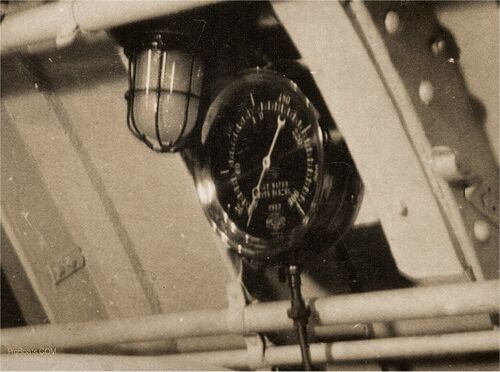
Photo in the collection of the Vallejo Naval & Historical Museum. Contributed by Darryl Baker
Control Room
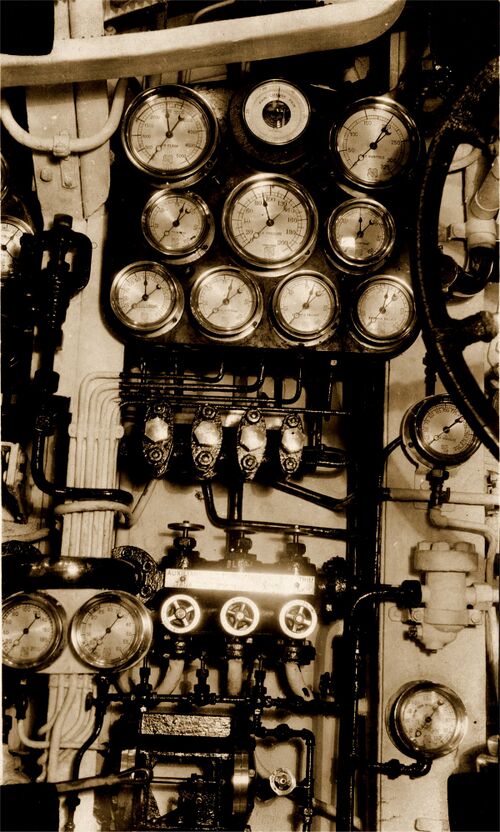






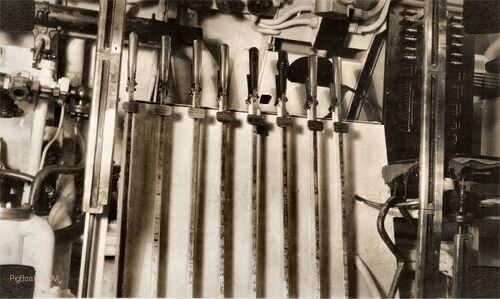

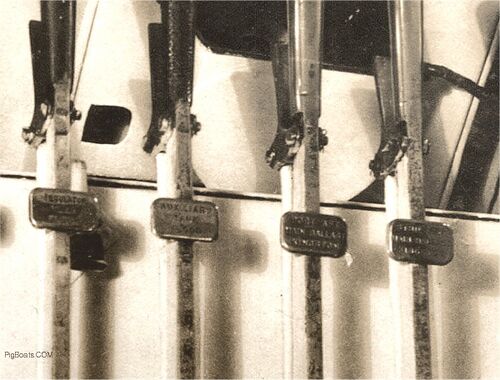


After Battery Compartment/Crew's Mess



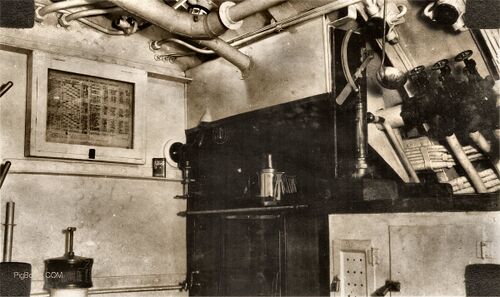


Engine Room
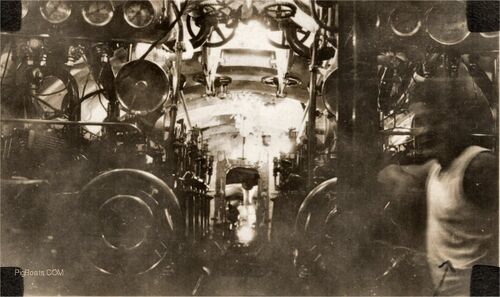
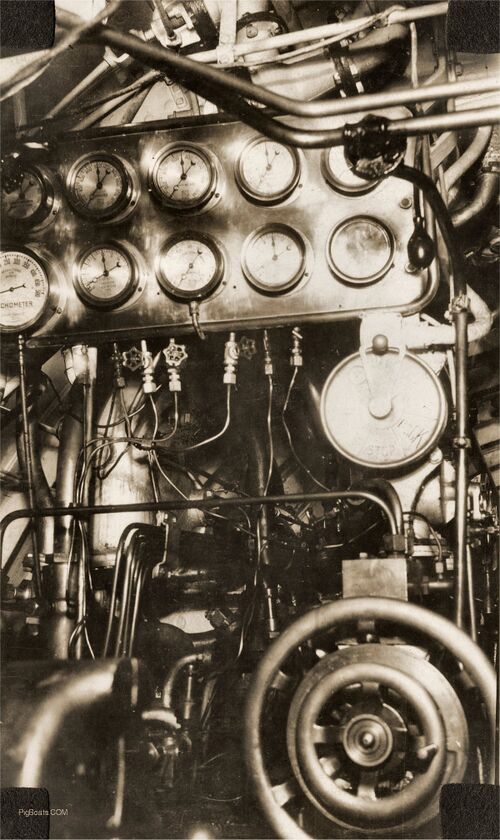


Motor Room

Page created by:
Ric Hedman & David Johnston
1999 - 2023 - PigBoats.COM©
Mountlake Terrace, WA, Norfolk, VA
webmaster at pigboats dot com
